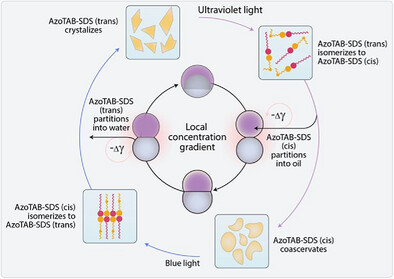New breakthrough in smart materials: colloidal systems that change shape with light
A team of researchers from the Liquid Crystals and Polymers Group at the Instituto de Nanociencia y Materiales de Aragón, a joint CSIC-UNIZAR institute, in collaboration with the Max Planck Institute of Colloids and Interfaces (Germany), has developed an innovative colloidal system capable of reversible and controlled shape change by light in just a few seconds. The work has been published in the prestigious journal Advanced Materials.
The study presents a new mechanism that allows micrometric droplets to behave like real ‘soft machines’: they can deform, move, split or merge in a matter of seconds. This behaviour is made possible by a light-induced reversible phase transition in surfactant mixtures, which allows the interfacial tension of the droplets to be controlled with great precision.
This breakthrough opens up new possibilities for the development of smart soft materials with broad applications. Their fast response, fully reversible and controllable with light, makes them particularly promising in fields such as soft robotics, targeted drug release or dynamic fluid manipulation at the microscopic scale.
You can read the full article here: https://advanced.onlinelibrary.wiley.com/doi/10.1002/adma.202506100?af=R.
“Reversible phase transitions of anionic and cationic surfactant mixtures drive shape morphing droplets”
Bradley D. Frank, Pilar Romero, Alberto Concellón, Lukas Zeininger
26th June 2025
Abstract:
Converting chemical signals into mechanical responses is fundamental to biological systems, driving processes such as cellular motility and tissue morphogenesis. Yet, harnessing chemo-mechanical signal conversions in synthetic systems remains a key challenge in energy-dissipative materials design. While droplets can move and interact with their environment reminiscent of active biological matter, chemo-mechanical interactions are limited by the translation of chemical changes into extensive force variations required on small timescales. Droplets naturally adopt spherical shapes to minimize surface-energy and restructuring liquids into non-equilibrium geometries requires mechanisms beyond current stimuli-responsive surfactant systems, which lack the force-amplifying mechanisms needed for transient liquid structuring. Here, a spring-like charging and latch-controlled release mechanism is introduced for actuating droplets. This is based on reversible, light-induced crystal-to-coacervate phase transitions of photo-responsive surfactant assemblies, namely between anionic sodium dodecylsulfate and cationic azobenzene-based surfactants. During phase-transition, reversible partitioning of the surfactants into the oil or aqueous phases of the emulsion transiently induce rapid changes in interfacial tensions, which are up to 900 times greater than those observed for conventional stimuli-responsive surfactant systems. The insights into this novel chemo-mechanical transduction mechanism provide new control over purely liquid systems, paving the way for programmable, hierarchically structured, all-liquid matter acting with physicality.









